

Embark NYC Wins MTA's Smartphone App Competition : Gothamist. City Gives Big Ups To These Big Apps: Gothamist. La RATP ouvre le coffre-fort de ses données pour améliorer l'information des voyageurs, Actualités. Toilet Tuesday: Of Course There's an App for Pooping - Technology - The Atlantic Cities. Welcome back to our weekly look at public restroom-related news from around the globe.
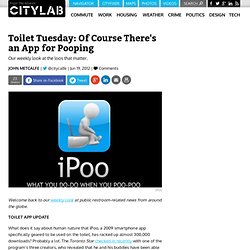
What does it say about human nature that iPoo, a 2009 smartphone app specifically geared to be used on the toilet, has racked up almost 300,000 downloads? Probably a lot. The Ridesharing Apps That Could Change The Way You Get To Work. The seemingly never-ending rise in gas prices has made ridesharing seem less like an opportunity for awkward small talk with a coworker and more like an easy way to save cash.

For drivers and riders who don't have easy access to a carpooling buddy, there is a growing group of ridesharing smartphone apps that can help (and in some cases, earn drivers some extra gas money in the process). Jut this week, ridesharing stalwart Zimride announced that it is opening itself up beyond college campuses. Below, we take a look at some of the most promising rideshare apps (including Zimride). Zimride San Francisco-based Zimride has actually been around since 2007, but up until this week, the online carpooling service was limited to university use. Sheltr App Helps You Direct The Homeless To Food, Shelter. In many big cities, it’s tough to navigate the world of homeless shelters and food resources.
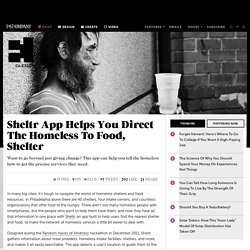
In Philadelphia alone there are 40 shelters, four intake centers, and countless organizations that offer food to the hungry. Arookoo, The Depressing App That "Makes Walking Fun" Every empire has its moments of decadence before its ultimate collapse.
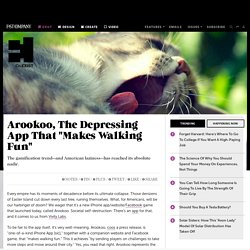
Those denizens of Easter Island cut down every last tree, ruining themselves. What, for Americans, will be our harbinger of doom? We wager that it's a new iPhone app/website/Facebook game that launched today, called Arookoo. A Handy App to Record Your Painful Bike Accident - Commute - The Atlantic Cities. The Bike Crash Kit for the iPhone contains all the things you need after getting run over by a car.
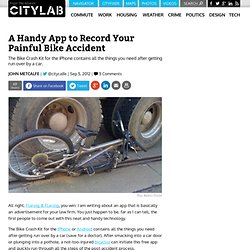
Do Real-Time Updates Increase Transit Ridership? - Commute - The Atlantic Cities. Late last month Wade Roush of Xconomy took a long look at how Google is changing the way people interact with their public transportation systems.
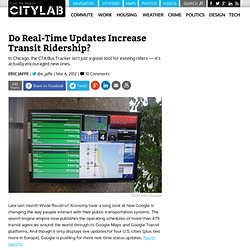
The search engine empire now publishes the operating schedules of more than 475 transit agencies around the world through its Google Maps and Google Transit platforms. And though it only displays live updates for four U.S. cities (plus two more in Europe), Google is pushing for more real-time status updates, Roush reports: Boston Does Digital: What We Can Learn From A City That Is Getting It Right. While driving around Boston one day, Nigel Jacob, co-chair of Boston’s Department of New Urban Mechanics, spied a group of public works employees at a job site staring intently at their phones.

Urban Planning in the iPhone Age - Technology - The Atlantic Cities. No one needs a good app quite like an urban planner.
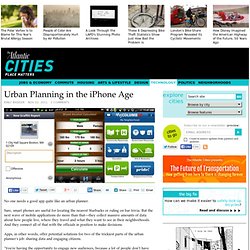
Sure, smart phones are useful for locating the nearest Starbucks or ruling on bar trivia. But the next wave of mobile applications do more than that—they collect massive amounts of data about how people live, where they travel and what they want to see in their neighborhoods. And they connect all of that with the officials in position to make decisions. Apps, in other words, offer potential solutions for two of the trickiest parts of the urban planner's job: sharing data and engaging citizens.
New Site, City Maps, Turns NYC Into Logorama: Gothamist. Elevate Your Thinking: Light, air and connectivity beyond the street. As we increasingly urbanize, relearning the craft of creating human-scaled places, I often — too often — hear that “if we just get the ground floor right” then all will be fine.

While obviously a good start, and one that addresses the most immediate of pedestrian interests, I find that this line of thinking ultimately allows, even incentivizes, buildings poorly designed above the first floor, thereby marginalizing the complete urban experience. The crescendo of urbanism? Nope, there is more to it! Vancouver-maven and UCLA PhD candidate, Neal LaMontagne, has consistently critiqued the full-block mid-rise buildings in Southern California as being bland, monotonous, and in opposition to the more visually alluring Vancouver model tower. A quick scroll through recent downtown San Diego projects on San Diego Urbdezine reveals a kernel of truth to Neal’s expert analysis. Co.Exist: World changing ideas and innovation. Having worked in the smart cities space for several years now, I am encouraged by the growth of the sector and the pace of technological advancements being developed for urban environments.
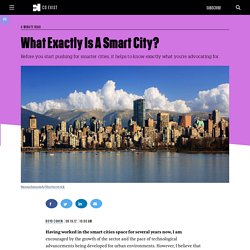
However, I believe that the smart-cities movement is being held back by a lack of clarity and consensus around what a smart city is and what the components of a smart city actually are. While some people continue to take a narrow view of smart cities by seeing them as places that make better use of information and communication technology (ICT), the cities I work with (and most of the participants in the #smartchat, a monthly Twitterchat about smart cities held on the first Wednesday of each month) all view smart cities as a broad, integrated approach to improving the efficiency of city operations, the quality of life for its citizens, and growing the local economy. Later this year, I’ll publish my annual rankings of smart cities here on Co.Exist. Co.Exist: World changing ideas and innovation.
Last year, I spent considerable time researching best practices for climate resilient cities—an endeavor that culminated in what I believe was the first ever global ranking of resilient cities. Now, after extensive research on smart cities initiatives around the globe, I have developed what may be the first ever global rankings of smart cities. The term "smart cities" is a bit ambiguous. Some people choose a narrow definition—i.e. cities that use information and communication technologies to deliver services to their citizens. I prefer a broader definition: Smart cities use information and communication technologies (ICT) to be more intelligent and efficient in the use of resources, resulting in cost and energy savings, improved service delivery and quality of life, and reduced environmental footprint—all supporting innovation and the low-carbon economy.
Kickstarting Open Source City Software: Transit App for iOS 6 and Beyond. The way we get around is changing. We increasingly combine bikes and transit. And in many cities we’re seeing a birth of whole new modes of transport like bike-share and carshare. Over at OpenPlans they build open source tools that are responsive to these changes and let us imagine new ways of moving and with the announcement of iOS version 6, Apple has dropped Google Maps and with it, previously built-in support for travel directions via public transit they are looking to kickstart a solution : With support, OpenTripPlanner Mobile, an open source application developed by OpenPlans will put transit back on the iPhone.
The app will also add new features that Google Maps didn’t have, allowing users to combine walking, bikes, bike-share and transit together, finding the fastest and most efficient trips regardless of mode of transportation. Sustainable Roof Opportunities - Facility Management Roofing Feature. StumbleUpon April 2012 - Roofing Roofs on institutional and commercial facilities used to be simply protective coverings for operations and equipment. But times have changed. A growing number of facilities now view rooftops as components that can provide significant value to the organization in the form of energy savings and sustainable attributes.
Although the basic function of reflective roof coatings remains the same as it has been for years, the way the products' attributes and functions are defined has changed many customers' perspective on the products. Sustainability.